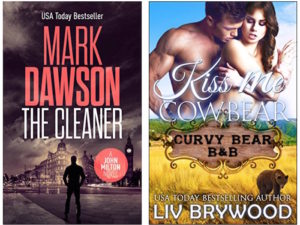
Quite honestly, I don’t know if women are from Venus and men, Mars. What I do know is that men and women look at the world differently. We can argue why this is until and even after the car is in the garage. The fact remains, the sexes see life from different perspectives. And in the end, that’s all that matters.
As a reader, as a male reader, I find I tend to gravitate towards certain types of books. And I am not just referring to genres here. I’m talking about characteristics. Such things as pacing, the amount of action, humor, violence, and sex.
A few months ago I referenced an article by Kate Summers, “Adult Reading Habits And Preferences In Relation To Gender Differences”. The article is informative and I think for the most part right on.
So I thought I’d revisit Ms Summer’s article and answer the questions she gave her survey participants. I dropped one of her questions and replaced it with one of my own. Here are the results (my answers are italicized):
1. How many books do you read in a year?
About two dozen or more.
2. Do you generally prefer fiction or nonfiction?
Fiction.
3. What nonfiction topics interest you?
Airships, history, philosophy, cooking, ships.
4. Do you have any favorite genres you like to read?
Mysteries, science fiction, adventure, sea stories.
5. Do you read series books or do you prefer standalone books?
Series.
6. What are a few of your favorite books?
An Artist Of The Floating World, The Remains Of The Day, Seneca’s Letters, Earth Abides, Day Of The Triffids, On The Beach, Wingman.
7. Do you have any favorite magazines?
No.
8. Who are a few of your favorite authors?
Kazuo Ishiguro, Daniel Pinkwater, Robert E. Howard, H.P. Lovecraft, H. Rider Haggard.
9. Do you typically prefer male authors or female authors?
Male authors.
10. Do you typically read books that feature male protagonists or female protagonists?
Male.
11. Were you encouraged to read when growing up?
Yes.
12. How do you choose books to read?
Subject, word of mouth, reviews.
13. Do you belong to a bookclub?
No.
14. Do you discuss books with your friends?
Not usually.
15. Are you an active member of any book related social networking sites?
No.
16. Do you own an ereader?
Yes.
17. In what format do you prefer to read, print or digital?
Doesn’t matter.
18. What kind of reading do you do online?
Nonfiction and research.
19. Do you become interested in reading a particular book if it is adapted into a movie or a TV series?
Not especially.
What I discovered is that my answers more or less fit in with those of fiction reading men. Good to know I’m normal, at least as far as reading is concerned.
In Kate Summers’s survey, women overwhelmingly preferred fiction to nonfiction. This may account for the perception amongst males that fiction reading is for “sissies”. And most males would rather die than be accused of being a sissy. Which may also account for men publicly declaring a preference for nonfiction.
I grew up in a family where reading was encouraged and my father read fiction. Consequently, fiction has always been part of my life and was nothing I was ashamed of. And I’m very glad for that.
Summers’s survey revealed women tend to be eclectic readers, having no preference overall for male or female protagonists or authors. On the other hand, a strong majority of men prefer male authors and male protagonists. This preference may be due to males more than females needing to identify with the characters. This was clearly seen in a survey of 11th grade boys and girls, where 43% of the boys compared to 35% of the girls cited needed to identify with the characters in a book.
Reading habits of men and women are important to writers — if the writer desires to write to a target audience.
Males tend to prefer action and humor. I discovered I’m a bit of an oddball in this regard as I don’t care for unrelenting and fast-paced action. I like action, but keep it to a few action scenes. I prefer plenty of non-action or little action and a whole lot of character development. Slowburn fiction is more my speed.
Females, on the other hand, tend to like romance and realistic fiction dealing with relationships.
As a writer, I find these preferences very interesting. It seems men tend to prefer plot-driven stories, with women preferring character-driven stories. Maybe that’s why men, for example, prefer thrillers (lots of action), whereas women prefer mysteries (especially cozies) where relationships and the characters’s personalities play a much larger role.
Every individual is, of course, unique. But generally speaking, it seems men and women form two different reader groups. What I see going on today amongst writers, both indie and traditionally published, is a catering to women readers at the expense of men. And this is taking place among both men and women writers.
The key to success, so we writers are told, no matter the genre or target audience (such as YA), is to have a kick-ass heroine. I think the underlying reason for this is the notion that in general men don’t read fiction. Which is, of course, not true. Men do read fiction. But men tend not to be social about their reading habits and therefore their reading choices generally don’t show up in surveys.
But we’ll save this part for next week, where we will examine the bias against men.
And if you are a man reading this post, please consider answering the questionnaire above that I took and put your answers in the comments.
Until next next time, happy reading!
Share This!